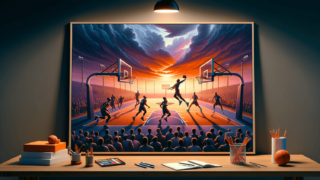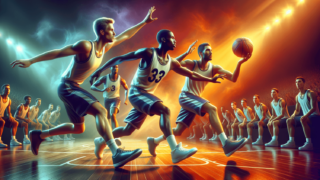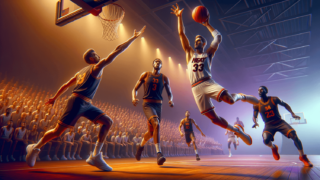
Are you a hoop dreamer, standing at a height you believe to be “vertically challenged” in the world of basketball? Fear not! In this riveting blog post, we’ll dive into the ever-important question, “Can short people play basketball?”. With a delightful blend of fun, facts, and expert insights, we’ll unpack the myth that towering stature is mandatory in the game. So, lace up your high tops and get ready to jump as high as your determination can take you, because we’re about to embark on a thrilling journey to discover how the little guys can still conquer the court with major aplomb!
Can Short People Play Basketball?
Yes, short people can certainly play basketball. While height can be advantageous in some aspects of the game, skills like agility, speed, ball-handling, and shooting ability can compensate for a lack of height. Throughout basketball history, there have been successful players who were considered short for their position, proving that talent, hard work, and determination are key factors in excelling at the sport.
The Success of Short Basketball Players
Though height does come into play in basketball, it’s important to note that many short players have thrived in the sport. From legends like Muggsy Bogues and Earl Boykins to contemporary hoopers like Isaiah Thomas and Nate Robinson, basketball boasts numerous success stories of shorter players defying stereotypes and excelling on the court. Let’s delve deeper into the career trajectories of such players who made height an afterthought.
Muggsy Bogues
Standing at a mere 5’3″, Muggsy Bogues holds the record for being the shortest player in NBA history. Despite his diminutive stature, Bogues was known for his speedy play, sharp passing, and pesky defense. Over his 14-year NBA career, Bogues averaged 7.7 points, 2.6 rebounds, 7.6 assists, and 1.5 steals per game. His performance on the court demonstrates that height doesn’t determine skill level, and it’s possible to compete with taller players through sheer talent and determination.
Earl Boykins
At 5’5″, Earl Boykins is the second-shortest player in the NBA’s annals. Featured in 652 games over a 13-year period, Boykins was both swift and agile with an uncanny ability to score. Averaging 8.9 points and 3.2 assists per game, Boykins made a lasting impact on the game and proved that shorter players could have fruitful careers in the NBA.
Isaiah Thomas
Selected as the last overall pick in the 2011 NBA Draft, Isaiah Thomas is an influential modern-era player coming in at 5’9″. Thomas enjoyed a remarkable stardom during his time with the Boston Celtics, especially during the 2016-2017 season when he was named an NBA All-Star for the second time. With an average of 28.9 points per game that season, Thomas demonstrated that height is not the sole determinant of success in basketball.
Nate Robinson
A three-time NBA Slam Dunk Contest champion, Nate Robinson stands at 5’9″ and boasts an impressive vertical leap. The epitome of raw athleticism, Robinson played for multiple teams throughout his 11-year NBA career, averaging 11 points, 2.3 rebounds, and 3 assists per game. This high-flying guard skillfully utilized his agility and strength, proving once again that the so-called “height disadvantage” can be overcome.
Tips for Short Players Mastering the Game
Although height may be a natural advantage in basketball, it’s important for shorter players to focus on attributes they can control. Here are several tips specific to shorter players seeking to hone their basketball skills:
Develop Superior Ball Handling
One way to even the playing field is by becoming a highly skilled ball-handler. Tall players with longer limbs are more susceptible to losing the ball in traffic; therefore, a shorter player with a low center of gravity can exploit this aspect by weaving through defenders to create scoring opportunities.
Focus on Speed and Quickness
Height is often accompanied by unwieldy movements, so shorter players should zero in on their speed and quickness to outpace taller opponents. Agility training, coupled with explosive sprint exercises, can help ensure that small-statured players are better equipped to dart around the court and create fast-break opportunities.
Enhance Shooting Skills
Being a proficient shooter is paramount for every basketball player, but it’s especially crucial for those on the shorter end. By honing versatile shooting techniques, including mid-range, long-range, and floaters in the paint, short players can overcome height limitations and become valuable scoring threats.
Adopt a Tenacious Defense
Short players, with their lower center of gravity and quick lateral movements, have the potential to become nightmarish on-ball defenders. By putting relentless pressure on ball-handlers and adepts in anticipating passes or interceptions, a low-stature, vibrant defender can transform the energy of a game.
Display Unrivaled Determination and Hustle
Challenging opponents at every turn and always giving maximum effort on the court helps close the height gap. Short players should relentlessly chase rebounds, box out competitors, and dive for loose balls to exhibit their grit and perseverance.
Successful Short Players in College Basketball
NCAA college basketball is yet another arena where shorter players can make names for themselves. From leaders like Spud Webb to modern stars such as Kihei Clark, these athletes have proven instrumental to winning national titles and leaving lasting impressions on the sport.
Spud Webb
Before earning a spot in the NBA, Spud Webb stood at 5’7″ while playing the point guard position for North Carolina State University. Webb showcased his innate ability to set up teammates and score when needed, garnering attention from NBA scouts and landing himself a professional career.
Kihei Clark
Listing at 5’9,” Kihei Clark has been a critical component of the University of Virginia’s basketball team. As a freshman, he helped the Cavaliers clinch their first-ever national championship in 2019, establishing himself as a fundamental part of the team’s success. His resilience and playmaking ability serves as an inspiration for aspiring short basketball players everywhere.
Short Players Can Excel Beyond the NBA
While the NBA might be the ultimate goal for many basketball players, it’s essential to acknowledge that success in the sport isn’t exclusive to this pinnacle league. Various opportunities for short players are available at different levels, including international leagues, semi-professional circuits, and recreational leagues. By seeking alternative pathways, short players can still find fulfillment and success in their basketball careers.
Conclusion
In summary, techniques and skills can overpower height as a dominant factor in determining success on the basketball court. With the right mindset, talent, and hard work, short players can excel in the sport through various avenues, breaking stereotypes and demonstrating their prowess one basket at a time.
Skills and Drills for Short Players to Excel
While shorter players can certainly find success in basketball, it’s essential to improve in specific areas and develop a set of skills tailored to their needs. The following are some exercises and drills to help short players hone their abilities and gain a competitive edge on the court:
1. Dribbling Drills
Improving ball control and dribbling is essential for players of any height, but especially for short players looking to utilize their low center of gravity. Experiment with different dribbling techniques, such as in-and-out, behind-the-back, and between-the-legs, and incorporate various speed and agility drills to sharpen dribbling skills under pressure.
2. Fast, High-Release Jump Shot
Since physical stature may make it difficult to shoot over taller defenders, short basketball players will want to refine their jump shots to increase speed and elevate the release point. Focus on getting shots off quickly, without sacrificing technique and accuracy. Enhance your vertical leap to create separation and more space for releasing jump shots.
3. Effective Cutting and Moving Without the Ball
A crucial component of successful team play lies in a player’s ability to move without the ball. Short players can learn how to use screens, make sharp and well-timed cuts, and find open spaces on the court to create opportunities for themselves and their teammates.
4. Floaters and Tear Drops
Perfecting the floater or tear drop allows a smaller player to adapt to their surroundings—especially when faced with taller shot-blockers in the paint. This versatile shot can be practiced with a soft, one-hand release or a two-hand push to find which method works best individually.
5. Spot-Up Shooting and Catch-and-Shoot
Furthermore, becoming an efficient spot-up and catch-and-shoot scorer can make a player a valuable asset to their team, regardless of their height. Perfecting this form of shooting requires practice, concentration, and timing. Focus on making quick decisions and maintaining a smooth and fast shooting form.
Physical Attributes That Benefit Short Players
While height does hold a natural advantage in certain areas of the game, short players can capitalize on specific physical attributes to shine in basketball:
1. Speed
The majority of short players boast explosive speed, enabling them to dash around the court and outpace their taller counterparts. Quick and agile players can make an immediate offensive and defensive impact, breaking down defenses or applying relentless on-ball pressure.
2. Lower Center of Gravity
Shorter players possess a lower center of gravity that benefits their balance, stability, and control when dribbling, changing directions, and stopping on a dime. Using this to their advantage allows short players to exploit taller defenders’ difficulties in keeping up with smaller, agile opponents.
3. High Stamina and Endurance
Short players typically boast great stamina and endurance, which comes in handy during intense, extended games. This physical characteristic grants them the ability to maintain a high level of energy on both offense and defense for longer periods. It also aids in recovery time, so they’re primed for the next big game.
FAQ Section: Tackling Common Questions on Short Players and Basketball
Curious about the challenges, advantages, and potential success of short players in the world of basketball? We’ve gathered 13 frequently asked questions on the topic, accompanied by concise answers to help broaden your perspective on this dynamic and exciting aspect of the game.
1. What is considered short for a basketball player?
In most leagues, a player under 6 feet is typically considered short, but the specific threshold may vary depending on the level of competition and each position’s height norms.
2. Are there any benefits to being a short basketball player?
Yes, short players can enjoy benefits such as speed, quickness, a lower center of gravity, superior ball control, and better stamina compared to taller counterparts.
3. Who is the shortest player to ever play in the NBA?
Muggsy Bogues, standing at 5’3″, is the shortest player in NBA history.
4. How do short players defend against tall opponents?
Short players can excel defensively by staying low, moving quickly, using their agility to deny passes, and leveraging their lower center of gravity for superior balance and stability.
5. How can a short player improve their rebounding?
Improving rebounding skills as a short player involves focusing on anticipation, positioning, boxing out, jumping ability, and pursuing the ball relentlessly.
6. What position is best for short basketball players?
Point guard is the best position for short basketball players, as it typically requires superior ball handling, passing, and decision-making skills—areas where shorter players can excel.
7. How do short players create their shot against taller defenders?
Short players can create shots by improving their shooting release speed, utilizing floaters and tear drops, making quick cuts, and capitalizing on the pick-and-roll.
8. How important is height in basketball?
While height can be advantageous in certain aspects of the game, factors like skill, determination, and hard work are more critical to a player’s success in basketball.
9. How can short players increase their prospects of making a high school or college team?
Short players can improve their chances by showcasing their unique skills, such as ball handling, shooting, speed, defense, and leadership.
10. Can a short basketball player get a scholarship?
Yes, a short basketball player can receive a scholarship if they prove themselves as an outstanding talent, possess a strong work ethic, and demonstrate leadership qualities.
11. How can short players compete against taller players?
Short players can compete against taller opponents by focusing on their strengths, such as agility, shooting, intelligent decision-making, and relentless hustle.
12. How can a short player improve their vertical leap?
Short players can enhance their vertical leap through targeted exercises, such as plyometrics, jump training, and strength training—focusing on leg muscles.
13. Are there any alternative leagues for short players to excel?
Yes, short players can thrive in alternative leagues such as international circuits, semi-professional leagues, and recreational leagues where height may be less of a determining factor.
Featured Posts
- No pillar pages found.





